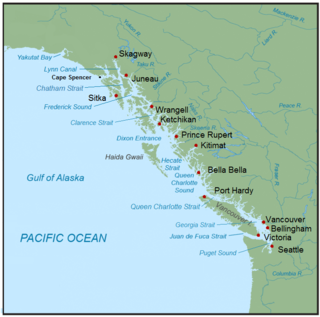| Dry Strait | |
|---|---|
| Location | Southeast Alaska, United States |
| Coordinates | 56°37′00″N132°32′55″W / 56.61667°N 132.54861°W Coordinates: 56°37′00″N132°32′55″W / 56.61667°N 132.54861°W |
| Type | Strait |
Dry Strait is an ocean strait separating Mitkof Island and Dry Island in Southeast Alaska, United States near the mouth of the Stikine River. At the time of Russian exploration in the region, the strait was known as Sukhoy Strait. [1] The strait is shallow and connects Frederick Sound in the north with Sumner Strait in the south. [2] Dry Island is part of mainland Alaska and is formed by distributaries of the Stikine that empty into the ocean to the north and south of Dry Strait. The strait received its name, presumably, due to the fact that it is often dry at low tide. [3]

Mitkof Island is an island in the Alexander Archipelago in southeast Alaska between Kupreanof Island to the west and the Alaskan mainland to the east. It is approximately 16 km (9.9 mi) wide and 28 km (17 mi) long with a land area of 539.7 km2 (208.4 sq mi), making it the 30th largest island in the United States. Much of the island is managed as part of the Tongass National Forest.

Southeast Alaska, colloquially referred to as the Alaska Panhandle or Alaskan Panhandle, is the southeastern portion of the U.S. state of Alaska, bordered to the east by the northern half of the Canadian province of British Columbia. The majority of Southeast Alaska's area is part of the Tongass National Forest, the United States' largest national forest. In many places, the international border runs along the crest of the Boundary Ranges of the Coast Mountains. The region is noted for its scenery and mild, rainy climate.

The United States of America (USA), commonly known as the United States or America, is a country comprising 50 states, a federal district, five major self-governing territories, and various possessions. At 3.8 million square miles, the United States is the world's third or fourth largest country by total area and is slightly smaller than the entire continent of Europe. With a population of over 327 million people, the U.S. is the third most populous country. The capital is Washington, D.C., and the most populous city is New York City. Most of the country is located contiguously in North America between Canada and Mexico.
Despite being the widest strait of the Inside Passage at this latitude, Dry Strait is less commonly used by marine vessels because the strait is strongly influenced by the shoaling waters of the Stikine River Delta. [2] The Stikine River Delta is continually expanding and depositing sediment on the ocean floor creating tidal flats throughout the strait. Marine traffic between Wrangell and Petersburg generally uses the narrower Wrangell Narrows between Mitkof and Kupreanof Islands while larger vessels will avoid the Inside Passage completely here and take an open ocean route via Chatham Strait.

The Inside Passage is a coastal route for ships and boats along a network of passages which weave through the islands on the Pacific NW coast of North America. The route extends from southeastern Alaska, in the United States, through western British Columbia, in Canada, to northwestern Washington state, in the United States. Ships using the route can avoid some of the bad weather in the open ocean and may visit some of the many isolated communities along the route. The Inside Passage is heavily travelled by cruise ships, freighters, tugs with tows, fishing craft and ships of the Alaska Marine Highway, BC Ferries, and Washington State Ferries systems.

The City and Borough of Wrangell is a borough in Alaska, United States. As of the 2010 census the population was 2,369, up from 2,308 in 2000. Incorporated as a Unified Home Rule Borough on May 30, 2008, Wrangell was previously a city in the Wrangell-Petersburg Census Area. Its Tlingit name is Ḵaachx̱aana.áakʼw. The Tlingit people residing in the Wrangell area, who were there centuries before Europeans, call themselves the Shtaxʼhéen Ḵwáan after the nearby Stikine River. Alternately they use the autonym Shxʼát Ḵwáan, where the meaning of shxʼát is unknown.

Petersburg is a census-designated place (CDP) in Petersburg Borough, Alaska, United States. The population was 2,948 at the 2010 census, down from 3,224 in 2000.







